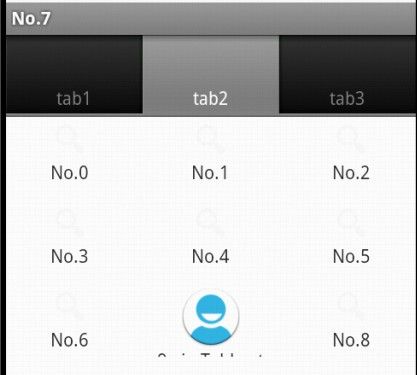Android入门/TabHost(十二)
TabHost
extends FrameLayoutimplements ViewTreeObserver.OnTouchModeChangeListener
| java.lang.Object | ||||
| ↳ | android.view.View | |||
| ↳ | android.view.ViewGroup | |||
| ↳ | android.widget.FrameLayout | |||
| ↳ | android.widget.TabHost | |||
类概述
一个窗口视图的容器。
这个对象包含两个孩子:一个标签页标签,用户点击来选择一个特定的标签,显示该网页的内容,一个FrameLayout对象。
个别元素通常是控制使用这个容器中的对象,而不是设置子元素本身的值。
TabHost API 传送: http://developer.android.com/reference/android/widget/TabHost.html
UI 布局 activity_main.xml
<?xml version="1.0" encoding="utf-8"?>
<TabHost
android:layout_width="match_parent"
android:layout_height="match_parent"
xmlns:android="http://schemas.android.com/apk/res/android"
android:id="@android:id/tabhost">
<TabWidget android:id="@android:id/tabs"
android:layout_height="wrap_content"
android:layout_width="fill_parent">
</TabWidget>
<FrameLayout
android:id="@android:id/tabcontent"
android:paddingTop="65dp"
android:layout_width="match_parent"
android:layout_height="match_parent">
<LinearLayout
android:layout_height="wrap_content"
android:id="@+id/Tab1"
android:orientation="horizontal"
android:layout_width="fill_parent">
<Button
android:layout_width="fill_parent"
android:layout_height="wrap_content"
android:id="@+id/btnTab1"
android:layout_weight="2"
android:text="Tab1">
</Button>
<EditText
android:layout_height="wrap_content"
android:id="@+id/edtTab1"
android:layout_weight="1"
android:textAppearance="@android:attr/autoCompleteTextViewStyle"
android:layout_width="fill_parent"
android:inputType="none">
</EditText>
</LinearLayout>
<LinearLayout
android:layout_height="wrap_content"
android:id="@+id/Tab2"
android:layout_width="fill_parent"
android:orientation="horizontal">
<GridView
xmlns:android="http://schemas.android.com/apk/res/android"
android:id="@+id/gridview"
android:layout_width="fill_parent"
android:layout_height="fill_parent"
android:numColumns="auto_fit"
android:verticalSpacing="10dp"
android:listSelector="@drawable/ic_launcher"
android:horizontalSpacing="10dp"
android:columnWidth="90dp"
android:stretchMode="columnWidth"
android:gravity="center"
/>
</LinearLayout>
<RelativeLayout
android:layout_height="wrap_content"
android:id="@+id/Tab3"
android:layout_width="fill_parent"
android:orientation="horizontal">
<EditText
android:layout_width="fill_parent"
android:layout_height="wrap_content"
android:textAppearance="@android:attr/autoCompleteTextViewStyle"
android:id="@+id/edtTab3"
android:inputType="none">
</EditText>
<ImageButton
android:id="@+id/imgbtn3"
android:layout_width="fill_parent"
android:layout_height="wrap_content"
android:src="@drawable/ai"
android:layout_below="@id/edtTab3"
android:contentDescription="@string/app_name"/>
</RelativeLayout>
</FrameLayout>
</TabHost>
night.xml
<?xml version="1.0" encoding="utf-8"?>
<RelativeLayout
xmlns:android="http://schemas.android.com/apk/res/android"
android:layout_height="wrap_content"
android:paddingBottom="4dp"
android:layout_width="fill_parent" >
<ImageView
android:layout_height="wrap_content"
android:layout_width="wrap_content"
android:id="@+id/ItemImage"
android:layout_centerHorizontal="true">
</ImageView>
<TextView
android:layout_width="wrap_content"
android:layout_below="@+id/ItemImage"
android:layout_height="wrap_content"
android:text="TextView"
android:layout_centerHorizontal="true"
android:id="@+id/ItemText">
</TextView>
</RelativeLayout>
Java代码
public class MainActivity extends TabActivity { // TabActivity
private Button btnTab1;
private ImageButton imgbtn3;
private EditText edtTab1,edtTab3;
public Context context;
public simple simpleAdapter;
private GridView gridview;
private final static String TAB1 = "tab1";
private final static String TAB2 = "tab2";
private final static String TAB3 = "tab3";
public void onCreate(Bundle savedInstanceState) {
super.onCreate(savedInstanceState);
PreUIInit();
UIInit();
PostUIInit();
Night();
}
private void PreUIInit()
{
setContentView(R.layout.activity_main);
// 得到TabHost对象
TabHost tabs = getTabHost();
//设置Tab1
TabSpec tab1 = tabs.newTabSpec(TAB1);
tab1.setIndicator(TAB1);
tab1.setContent(R.id.Tab1); // Tab1 --> LinearLayout @+id/Tab1
tabs.addTab(tab1);
//设置Tab2
TabSpec tab2 = tabs.newTabSpec(TAB2);
tab2.setIndicator(TAB2);
tab2.setContent(R.id.Tab2);
tabs.addTab(tab2);
//设置Tab3
TabSpec tab3 = tabs.newTabSpec(TAB3);
tab3.setIndicator(TAB3);
tab3.setContent(R.id.Tab3);
tabs.addTab(tab3);
}
private void UIInit()
{
// tab1
btnTab1=(Button)this.findViewById(R.id.btnTab1);
edtTab1=(EditText)this.findViewById(R.id.edtTab1);
// tab3
imgbtn3=(ImageButton)this.findViewById(R.id.imgbtn3);
edtTab3=(EditText)this.findViewById(R.id.edtTab3);
}
private void PostUIInit()
{
btnTab1.setOnClickListener(listener);
imgbtn3.setOnClickListener(listener);
}
private OnClickListener listener = new OnClickListener()
{
public void onClick(View v) {
switch (v.getId()) {
case R.id.btnTab1:
edtTab1.setText(TAB1);
break;
case R.id.imgbtn3:
edtTab3.setText(TAB3);
break;
}
}
};
private void Night()
{
/** 1. 处理好数据 , 生成动态数组 */
gridview = (GridView)findViewById(R.id.gridview);
ArrayList<HashMap<String, Object>> list = new ArrayList<HashMap<String,Object>>();
for(int i=0;i<9;i++)
{
HashMap<String, Object> map = new HashMap<String, Object>();
map.put("ItemImage", R.drawable.ic_action_search);
map.put("ItemText", "No."+i);
//添加到动态数组
list.add(map);
}
/** 2. 生成适配器 */
simpleAdapter = new simple(this,
list, //数据源
R.layout.night, //Items 布局
new String[]{"ItemImage","ItemText"},// 动态数组list 对应的子项的名称
new int[]{R.id.ItemImage,R.id.ItemText}// night.xml 内对应组件的id
);
/** 3. gridview添加并且显示
4.添加消息处理
*/
gridview.setAdapter(simpleAdapter);
gridview.setOnItemClickListener(Itemlistener);
}
// OnItemClickListener 事件处理
private OnItemClickListener Itemlistener = new OnItemClickListener() {
public void onItemClick(AdapterView<?> parent, //AdapterView被点击时发生
View view, //AdapterView内被点击的视图
int position, //适配器中的位置的视图
long id) //被点击的项行的id
{
@SuppressWarnings("unchecked")
HashMap<String, Object> item = (HashMap<String, Object>)parent.getItemAtPosition(position);
//显示所选Item的ItemText
setTitle((String)item.get("ItemText"));
Log.v("ONITEMCLICK","position = "+position);
simpleAdapter.setSelected(position);
//simpleAdapter.setContext(context);
}
};
/** 内部类 Adapter*/
public class simple extends SimpleAdapter{
private List<HashMap<String, Object>> list;
private int selected = -1;
//private Context context;
// 继承父类的构造
public simple(Context context, List<HashMap<String, Object>> data,
int resource, String[] from, int[] to)
{
super(context, data, resource, from, to);
this.list = data;
}
// 获取当前点击的位置
public void setSelected(int position)
{
this.selected = position;
notifyDataSetChanged();
Toast.makeText(MainActivity.this, "selected = "+selected, Toast.LENGTH_SHORT).show();
}
// 获得Items的数量
public int getCount()
{
return this.list.size();
}
// 根据ListView位置返回View
public Object getItem(int position)
{
return this.list.get(position);
}
// 根据ListView位置得到List中的ID
public long getItemId(int position)
{
return position;
}
// 根据位置得到View对象 3个参数[ List中的ID ],[ Items的视图 ],[ 父类的视图 ]
public View getView(int position, View convertView,ViewGroup parent)
{
Log.v("getView", "position = "+position);
if(selected == position)
{
// 大致作用是 绑定 layout布局文件 ,和findViewById差不多作用,只是一个是找Widget控件 ,一个是找Layout布局文件
LayoutInflater inflater = (LayoutInflater)MainActivity.this.getSystemService(Context.LAYOUT_INFLATER_SERVICE);
convertView = inflater.inflate(R.layout.night, null);
ImageView img = (ImageView)convertView.findViewById(R.id.ItemImage);
img.setImageResource(R.drawable.ic_launcher);
TextView text = (TextView)convertView.findViewById(R.id.ItemText);
text.setText(R.string.app_name);
return convertView;
}
return super.getView(position, convertView, parent);
}
}
}
